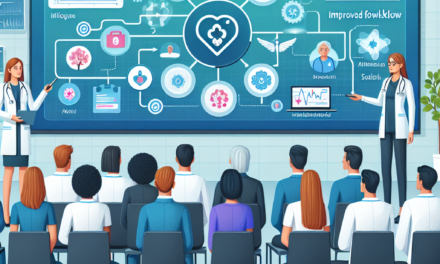Unlocking the Digital Gateway to Healthcare

The digital revolution has transformed numerous industries, and healthcare is no exception. As technology continues to evolve, it offers unprecedented opportunities to enhance patient care, streamline operations, and improve health outcomes. This article delves into the concept of the digital gateway to healthcare, exploring how digital tools and technologies are reshaping the landscape of healthcare delivery. We will examine five key subtopics: telemedicine, electronic health records (EHRs), wearable technology, artificial intelligence (AI) in healthcare, and patient engagement through digital platforms.
Telemedicine: Bridging the Gap in Healthcare Access
Telemedicine has emerged as a vital component of modern healthcare, offering a solution to the challenges of accessibility and convenience. By leveraging telecommunications technology, telemedicine enables healthcare providers to deliver care remotely, breaking down geographical barriers and improving access to medical services.
The Rise of Telemedicine
Telemedicine has seen exponential growth in recent years, driven by advancements in technology and the increasing demand for convenient healthcare solutions. The COVID-19 pandemic further accelerated its adoption, as healthcare systems worldwide sought to minimize in-person interactions to curb the spread of the virus. According to a report by McKinsey & Company, telehealth utilization increased 38 times from the pre-COVID-19 baseline.
Telemedicine encompasses a wide range of services, including virtual consultations, remote monitoring, and teletherapy. These services are delivered through various platforms, such as video conferencing, mobile apps, and secure messaging systems. The flexibility and convenience of telemedicine have made it an attractive option for both patients and healthcare providers.
Benefits of Telemedicine
Telemedicine offers numerous benefits that contribute to its growing popularity:
- Improved Access: Telemedicine eliminates the need for patients to travel long distances to access healthcare services, making it particularly beneficial for individuals in rural or underserved areas.
- Convenience: Patients can schedule appointments at their convenience and receive care from the comfort of their homes, reducing the need for time off work or childcare arrangements.
- Cost-Effectiveness: Telemedicine can reduce healthcare costs by minimizing the need for physical infrastructure and reducing hospital readmissions through better chronic disease management.
- Enhanced Patient Engagement: Telemedicine encourages patients to take an active role in their healthcare by providing easy access to medical professionals and health information.
Challenges and Considerations
Despite its advantages, telemedicine also presents challenges that need to be addressed:
- Technology Barriers: Not all patients have access to the necessary technology or internet connectivity to participate in telemedicine services.
- Regulatory and Reimbursement Issues: The regulatory landscape for telemedicine varies by region, and reimbursement policies can be complex and inconsistent.
- Privacy and Security Concerns: Ensuring the confidentiality and security of patient data is crucial in telemedicine, requiring robust cybersecurity measures.
Case Study: Telemedicine in Rural Communities
A notable example of telemedicine’s impact is its implementation in rural communities. In areas with limited access to healthcare facilities, telemedicine has proven to be a lifeline. For instance, the University of Mississippi Medical Center’s telehealth program has successfully provided remote care to patients in rural Mississippi, reducing travel time and improving health outcomes.
Through telemedicine, patients in these communities can access specialists and receive timely care, leading to better management of chronic conditions and reduced hospitalizations. This case study highlights the potential of telemedicine to address healthcare disparities and improve access to quality care.
The Future of Telemedicine
As technology continues to advance, the future of telemedicine looks promising. Innovations such as virtual reality (VR) consultations, remote patient monitoring devices, and AI-driven diagnostic tools are expected to enhance the capabilities of telemedicine further. Additionally, as regulatory frameworks evolve and reimbursement policies become more favorable, telemedicine is likely to become an integral part of mainstream healthcare delivery.
In conclusion, telemedicine is a powerful tool that has the potential to revolutionize healthcare access and delivery. By overcoming geographical barriers and providing convenient, cost-effective care, telemedicine is unlocking new possibilities for patients and healthcare providers alike.
Electronic Health Records: Transforming Data Management
Electronic Health Records (EHRs) have become a cornerstone of modern healthcare, revolutionizing the way patient data is managed and shared. By digitizing medical records, EHRs enhance the efficiency, accuracy, and accessibility of healthcare information, ultimately improving patient care and outcomes.
The Evolution of EHRs
The transition from paper-based records to electronic health records has been a gradual process, driven by the need for more efficient data management and improved patient care. The Health Information Technology for Economic and Clinical Health (HITECH) Act of 2009 played a significant role in promoting the adoption of EHRs in the United States by providing financial incentives to healthcare providers.
Today, EHRs are widely used across healthcare systems, enabling the seamless exchange of patient information among healthcare providers. This interoperability is crucial for ensuring continuity of care and reducing medical errors.
Benefits of EHRs
EHRs offer numerous advantages that contribute to their widespread adoption:
- Improved Data Accuracy: EHRs reduce the risk of errors associated with manual data entry and handwriting, ensuring that patient information is accurate and up-to-date.
- Enhanced Coordination of Care: EHRs facilitate the sharing of patient information among healthcare providers, enabling better coordination of care and reducing the risk of duplicate tests or procedures.
- Increased Efficiency: EHRs streamline administrative tasks, such as appointment scheduling and billing, allowing healthcare providers to focus more on patient care.
- Better Patient Engagement: EHRs provide patients with access to their health information, empowering them to take an active role in managing their health.
Challenges and Considerations
Despite their benefits, EHRs also present challenges that need to be addressed:
- Interoperability Issues: While EHRs are designed to facilitate data sharing, interoperability between different EHR systems remains a challenge, hindering the seamless exchange of information.
- Privacy and Security Concerns: Protecting patient data from unauthorized access and breaches is a critical concern, requiring robust cybersecurity measures.
- User Experience: The complexity of some EHR systems can lead to user frustration and decreased productivity, highlighting the need for user-friendly interfaces.
Case Study: EHR Implementation at Kaiser Permanente
Kaiser Permanente, one of the largest healthcare organizations in the United States, successfully implemented an EHR system known as HealthConnect. This system integrates patient information across all Kaiser Permanente facilities, enabling seamless data sharing and improving care coordination.
The implementation of HealthConnect has led to significant improvements in patient care, including reduced hospital readmissions and improved chronic disease management. This case study demonstrates the potential of EHRs to enhance healthcare delivery and outcomes.
The Future of EHRs
The future of EHRs is promising, with ongoing advancements in technology and data analytics expected to enhance their capabilities further. Innovations such as blockchain technology and AI-driven data analysis are poised to address interoperability and data security challenges, making EHRs more efficient and secure.
In conclusion, EHRs are a transformative tool that has revolutionized data management in healthcare. By improving data accuracy, enhancing care coordination, and empowering patients, EHRs are unlocking new possibilities for healthcare delivery and outcomes.
Wearable Technology: Empowering Patients and Providers
Wearable technology has emerged as a game-changer in healthcare, offering new ways to monitor health, track fitness, and manage chronic conditions. By providing real-time data and insights, wearables empower both patients and healthcare providers to make informed decisions and improve health outcomes.
The Rise of Wearable Technology
The wearable technology market has experienced rapid growth in recent years, driven by advancements in sensor technology and the increasing demand for personalized health solutions. According to a report by Grand View Research, the global wearable technology market is expected to reach $118.16 billion by 2028, growing at a compound annual growth rate (CAGR) of 13.8% from 2021 to 2028.
Wearable devices encompass a wide range of products, including fitness trackers, smartwatches, and medical-grade devices. These devices are equipped with sensors that monitor various health metrics, such as heart rate, sleep patterns, and physical activity levels.
Benefits of Wearable Technology
Wearable technology offers numerous benefits that contribute to its growing popularity:
- Real-Time Health Monitoring: Wearables provide continuous monitoring of health metrics, enabling early detection of potential health issues and timely intervention.
- Personalized Health Insights: Wearables offer personalized insights and recommendations based on individual health data, empowering users to make informed lifestyle choices.
- Improved Chronic Disease Management: Wearables can help individuals with chronic conditions, such as diabetes or hypertension, monitor their health and manage their conditions more effectively.
- Enhanced Patient Engagement: Wearables encourage users to take an active role in their health by providing real-time feedback and motivation to achieve health goals.
Challenges and Considerations
Despite their advantages, wearable technology also presents challenges that need to be addressed:
- Data Privacy and Security: Protecting the sensitive health data collected by wearables is crucial, requiring robust cybersecurity measures and compliance with data protection regulations.
- Accuracy and Reliability: Ensuring the accuracy and reliability of data collected by wearables is essential for making informed health decisions.
- User Adoption and Engagement: Encouraging long-term user adoption and engagement with wearable devices can be challenging, requiring user-friendly designs and meaningful insights.
Case Study: Wearable Technology in Cardiac Care
A notable example of wearable technology’s impact is its use in cardiac care. The Apple Watch, equipped with an electrocardiogram (ECG) feature, has been used to detect irregular heart rhythms and atrial fibrillation in users. A study published in the New England Journal of Medicine found that the Apple Watch’s ECG feature accurately identified atrial fibrillation in participants, demonstrating its potential as a valuable tool for cardiac monitoring.
This case study highlights the potential of wearable technology to enhance cardiac care by providing real-time monitoring and early detection of heart conditions.
The Future of Wearable Technology
The future of wearable technology is promising, with ongoing advancements in sensor technology and data analytics expected to enhance their capabilities further. Innovations such as smart clothing, implantable devices, and AI-driven health insights are poised to revolutionize the wearable technology landscape.
In conclusion, wearable technology is a powerful tool that has the potential to transform healthcare by empowering patients and providers with real-time health data and insights. By improving health monitoring, personalized care, and patient engagement, wearables are unlocking new possibilities for health management and outcomes.
Artificial Intelligence in Healthcare: Revolutionizing Diagnosis and Treatment
Artificial Intelligence (AI) is transforming healthcare by revolutionizing the way diseases are diagnosed and treated. By leveraging machine learning algorithms and data analytics, AI offers new possibilities for improving accuracy, efficiency, and outcomes in healthcare delivery.
The Role of AI in Healthcare
AI has become an integral part of modern healthcare, with applications ranging from diagnostic imaging to personalized medicine. The ability of AI to analyze vast amounts of data and identify patterns has made it a valuable tool for healthcare providers seeking to improve patient care.
According to a report by Accenture, the AI healthcare market is expected to reach $6.6 billion by 2021, with a projected annual growth rate of 40%. This growth is driven by the increasing demand for AI-driven solutions that enhance clinical decision-making and streamline healthcare operations.
Benefits of AI in Healthcare
AI offers numerous benefits that contribute to its growing adoption in healthcare:
- Improved Diagnostic Accuracy: AI algorithms can analyze medical images and data with high precision, leading to more accurate diagnoses and reduced diagnostic errors.
- Personalized Treatment Plans: AI can analyze patient data to develop personalized treatment plans tailored to individual needs and preferences.
- Enhanced Efficiency: AI can automate routine tasks, such as data entry and appointment scheduling, allowing healthcare providers to focus more on patient care.
- Predictive Analytics: AI can analyze patient data to identify trends and predict potential health issues, enabling proactive interventions and improved outcomes.
Challenges and Considerations
Despite its advantages, AI in healthcare also presents challenges that need to be addressed:
- Data Privacy and Security: Ensuring the privacy and security of patient data used in AI applications is crucial, requiring compliance with data protection regulations.
- Bias and Fairness: AI algorithms can be biased if trained on unrepresentative data, leading to disparities in healthcare outcomes.
- Integration with Existing Systems: Integrating AI solutions with existing healthcare systems can be complex and require significant resources.
Case Study: AI in Radiology
A notable example of AI’s impact is its use in radiology. AI algorithms have been developed to analyze medical images, such as X-rays and MRIs, with high accuracy. For instance, a study published in Nature Medicine demonstrated that an AI algorithm developed by Google Health outperformed radiologists in detecting breast cancer in mammograms.
This case study highlights the potential of AI to enhance diagnostic accuracy and improve patient outcomes in radiology.
The Future of AI in Healthcare
The future of AI in healthcare is promising, with ongoing advancements in machine learning and data analytics expected to enhance its capabilities further. Innovations such as natural language processing (NLP) and AI-driven drug discovery are poised to revolutionize the healthcare landscape.
In conclusion, AI is a transformative tool that has the potential to revolutionize healthcare by improving diagnostic accuracy, personalizing treatment plans, and enhancing efficiency. By unlocking new possibilities for diagnosis and treatment, AI is paving the way for a new era of healthcare delivery.
Patient Engagement Through Digital Platforms: Empowering Patients in Their Health Journey
Digital platforms have become a powerful tool for engaging patients in their health journey, offering new ways to access information, communicate with healthcare providers, and manage health conditions. By empowering patients with digital tools, healthcare systems can improve patient satisfaction, adherence to treatment plans, and health outcomes.
The Role of Digital Platforms in Patient Engagement
Digital platforms encompass a wide range of tools and technologies, including patient portals, mobile apps, and online communities. These platforms provide patients with access to their health information, educational resources, and communication channels with healthcare providers.
According to a report by Deloitte, digital health technologies have the potential to improve patient engagement by providing personalized health information and facilitating communication with healthcare providers.
Benefits of Patient Engagement Through Digital Platforms
Digital platforms offer numerous benefits that contribute to improved patient engagement:
- Access to Health Information: Digital platforms provide patients with easy access to their health records, test results, and educational resources, empowering them to make informed decisions about their health.
- Improved Communication: Digital platforms facilitate communication between patients and healthcare providers, enabling timely responses to questions and concerns.
- Personalized Health Management: Digital platforms offer personalized health management tools, such as medication reminders and wellness trackers, to support patients in managing their health conditions.
- Enhanced Patient Satisfaction: By providing convenient access to healthcare services and information, digital platforms can improve patient satisfaction and adherence to treatment plans.
Challenges and Considerations
Despite their advantages, digital platforms also present challenges that need to be addressed:
- Digital Literacy: Ensuring that all patients have the necessary digital literacy skills to use digital platforms effectively is crucial for maximizing their benefits.
- Data Privacy and Security: Protecting patient data from unauthorized access and breaches is a critical concern, requiring robust cybersecurity measures.
- User Engagement: Encouraging long-term user engagement with digital platforms can be challenging, requiring user-friendly designs and meaningful insights.
Case Study: Patient Portals in Chronic Disease Management
A notable example of digital platforms’ impact is their use in chronic disease management. Patient portals have been used to support individuals with chronic conditions, such as diabetes or hypertension, by providing access to health information, medication reminders, and communication channels with healthcare providers.
A study published in the Journal of Medical Internet Research found that patients who used patient portals for chronic disease management reported improved health outcomes and higher satisfaction with their care.
This case study highlights the potential of digital platforms to enhance patient engagement and improve health outcomes in chronic disease management.
The Future of Patient Engagement Through Digital Platforms
The future of patient engagement through digital platforms is promising, with ongoing advancements in technology and data analytics expected to enhance their capabilities further. Innovations such as virtual health assistants, AI-driven health insights, and personalized health coaching are poised to revolutionize patient engagement.
In conclusion, digital platforms are a powerful tool that has the potential to transform patient engagement by empowering patients with access to information, communication channels, and personalized health management tools. By improving patient satisfaction, adherence to treatment plans, and health outcomes, digital platforms are unlocking new possibilities for patient-centered care.
Conclusion
The digital gateway to healthcare is unlocking new possibilities for enhancing patient care, streamlining operations, and improving health outcomes. Through the adoption of telemedicine, electronic health records, wearable technology, artificial intelligence, and digital platforms, healthcare systems are transforming the way care is delivered and experienced.
Telemedicine is bridging the gap in healthcare access by providing convenient, cost-effective care to patients in remote or underserved areas. Electronic health records are revolutionizing data management by improving data accuracy, care coordination, and patient engagement. Wearable technology is empowering patients and providers with real-time health data and insights, enhancing health monitoring and personalized care. Artificial intelligence is revolutionizing diagnosis and treatment by improving diagnostic accuracy, personalizing treatment plans, and enhancing efficiency. Digital platforms are empowering patients in their health journey by providing access to information, communication channels, and personalized health management tools.
As technology continues to evolve, the future of healthcare looks promising. By embracing digital tools and technologies, healthcare systems can unlock new possibilities for improving patient care, outcomes, and experiences. The digital gateway to healthcare is paving the way for a new era of healthcare delivery, where patients are empowered, providers are supported, and health outcomes are optimized.





